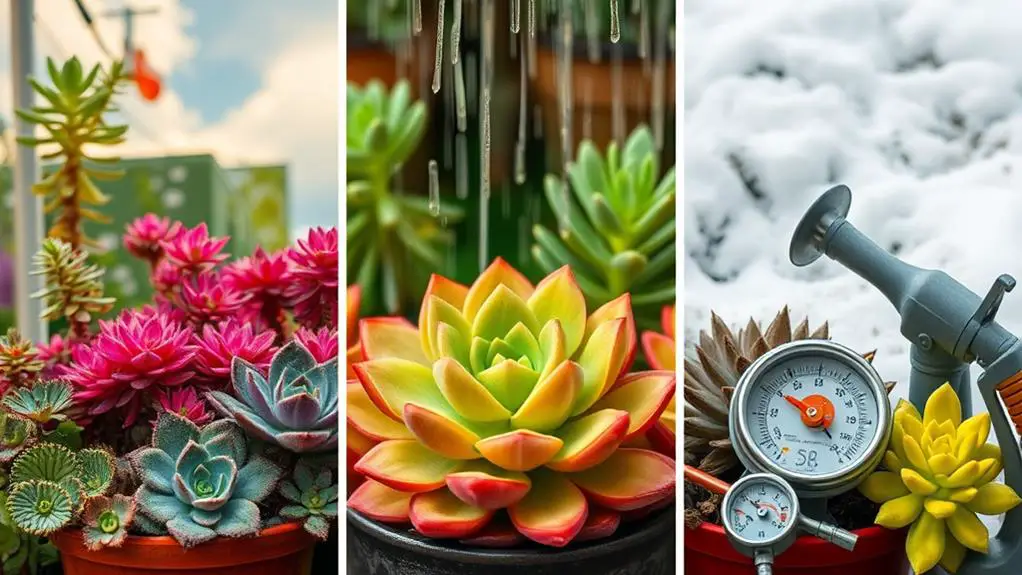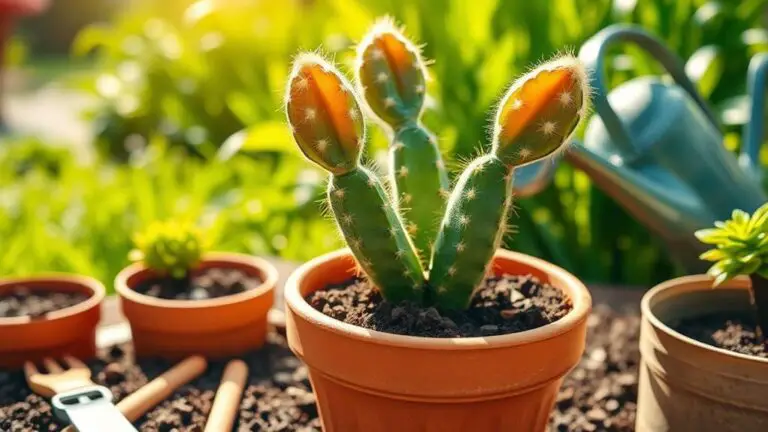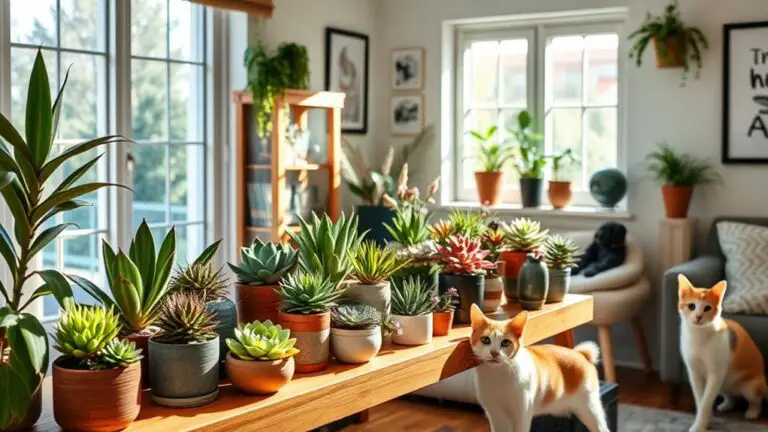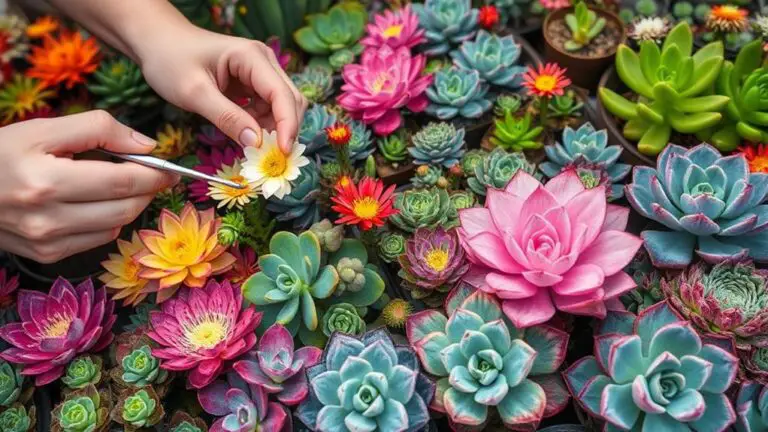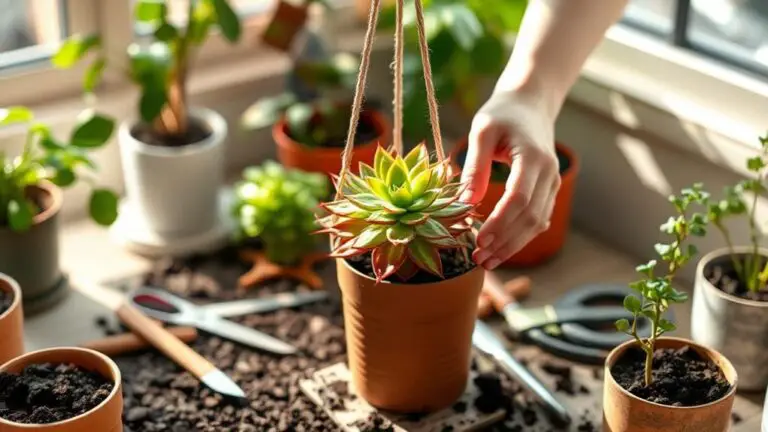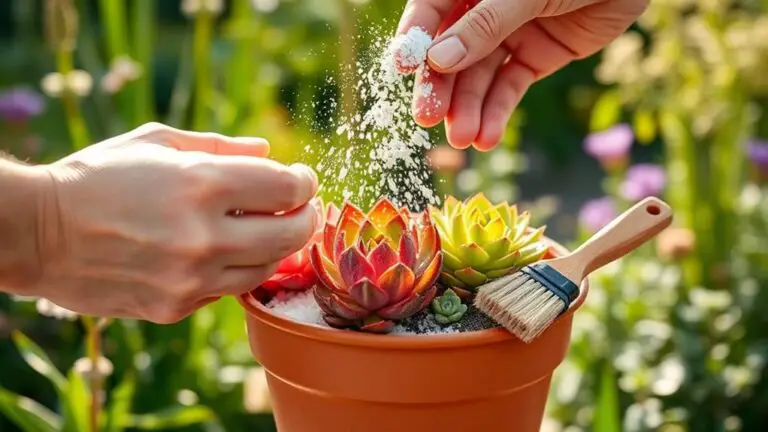9 Tips for Helping Succulents React to Different Weather Conditions
Caring for succulents can be tricky, especially when the weather changes. You'll need to monitor temperature and humidity levels closely to keep your plants healthy. Ever wondered how to prevent sunburn during peak heat or why terracotta pots are better for insulation? And what about watering schedules or protecting your plants from frost? By taking these steps, you can guarantee your succulents thrive no matter the season. Let's explore these nine essential tips to keep your succulents in top shape, starting with the secrets to managing high temperatures effectively.
Optimal Temperature Range
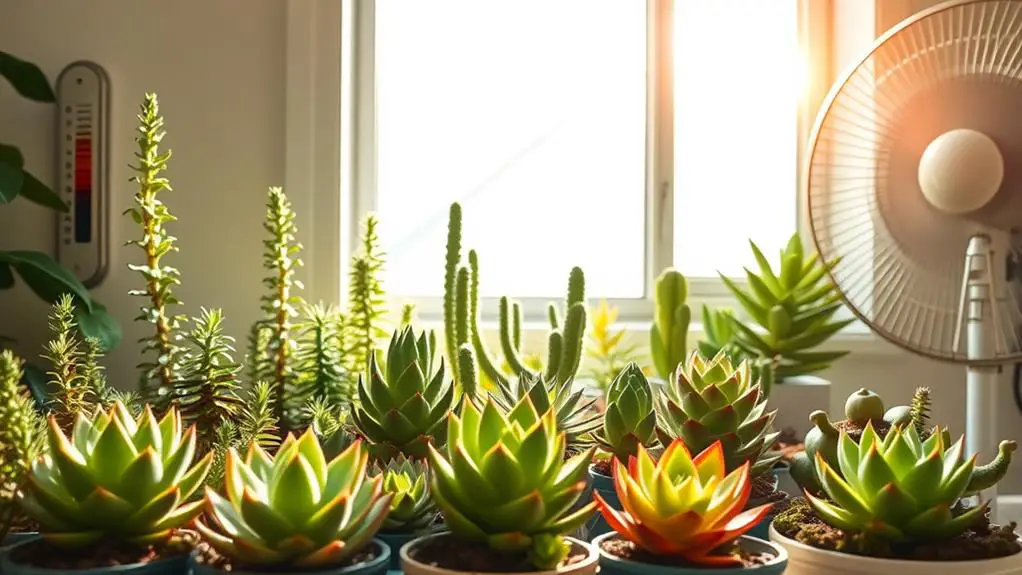
When it comes to keeping your succulents happy, understanding their ideal temperature range is essential. Succulents thrive best within an ideal temperature range of 60°F to 80°F, which promotes their growth and health.
They can tolerate temperatures as low as 40°F and as high as 90°F, but prolonged exposure outside this range may stress them. Extended exposure to temperatures above 80°F can cause sunburn, damaging leaves and roots. Moving them to shaded areas during peak sun hours can help.
Ground planting offers more temperature stability, protecting succulents from extreme conditions. If temperatures dip below 40°F, especially for non-cold-hardy varieties, consider indoor relocation or using protective coverings to prevent frost damage.
Managing High Temperatures
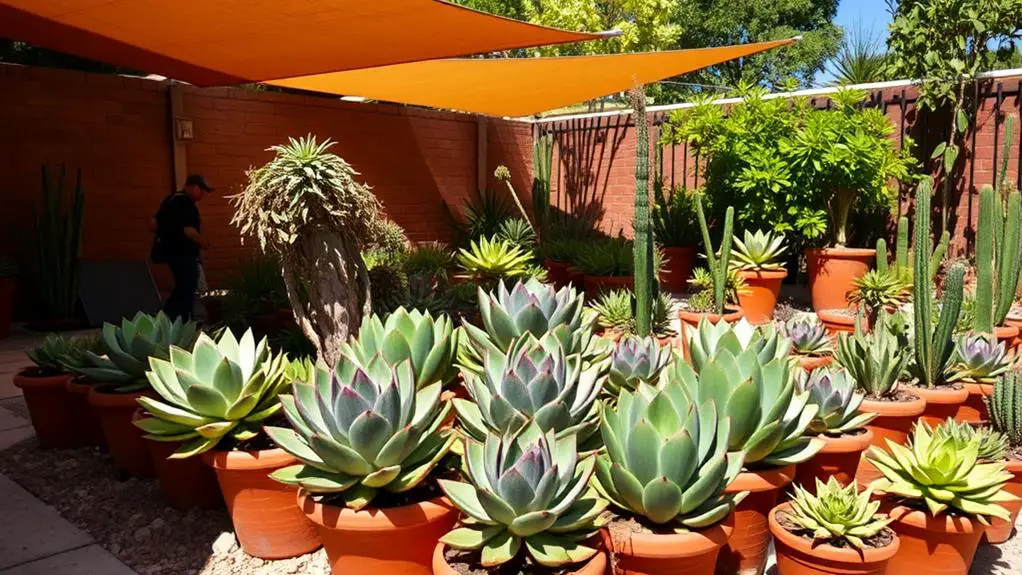
When temperatures soar, it's crucial to protect your succulents to keep them healthy.
Move them to shaded areas during peak sun hours, especially in the afternoon, and choose containers made of concrete or terracotta to help insulate them from the heat.
Don't forget to regularly check the soil moisture, as hot weather can cause it to dry out quickly.
Shade During Peak Hours
During peak sunlight hours, usually from late morning to mid-afternoon, it is crucial to provide succulents with shade to prevent sunburn and leaf damage, especially when temperatures soar above 80°F. Relocating your plants to shaded areas or using shade cloth can help keep temperatures within the ideal range of 60°F to 80°F. Ground planting offers better temperature stability compared to containers, making it easier to manage high heat. Soft succulents are particularly vulnerable to sunburn, so give them immediate shade if temperatures stay above 80°F. Gradually acclimatizing newly planted or indoor succulents to direct sunlight will help them adapt without shock.
| Condition | Action | Benefit |
|---|---|---|
| Peak Sunlight | Provide Shade | Prevent Sunburn |
| High Temps | Use Shade Cloth | Maintain Ideal Temps |
| Ground Planting | Stable Heat | Easier Management |
Suitable Container Choices
Selecting the right containers for your succulents is essential when managing high temperatures.
Concrete, terracotta, and ceramic containers are excellent choices since they provide better insulation, helping maintain stable soil temperatures. Unlike glass and metal, which can cause rapid temperature changes, these materials protect your plants from overheating.
Opting for larger containers can also be beneficial. They retain moisture and temperature more effectively, allowing succulents to thrive in hot weather.
Here are some points to take into account:
- Concrete and terracotta containers offer great insulation.
- Ceramic pots help stabilize soil temperature.
- Avoid glass and metal containers to prevent temperature fluctuations.
- Larger containers retain moisture better, aiding in heat management.
Monitor Soil Moisture
Maintaining the right soil moisture is essential for your succulents, especially as the temperatures soar. When temperatures rise above 80°F, check soil moisture regularly.
Allow the top 1-2 inches of soil to dry out between waterings to prevent root rot. Use well-draining soil with gravel and perlite to help excess moisture escape.
Water early in the morning or late in the evening to minimize evaporation. This helps the plants absorb moisture effectively before the heat of the day.
Relocating your succulents to shaded areas during peak sun hours can reduce stress and help the soil retain moisture longer.
Choosing the Right Containers

Picking the right containers for your succulents is essential for their health and longevity. The choice of containers impacts how well your plants handle temperature fluctuations and moisture levels.
Opt for materials like concrete, terracotta, ceramic, and wood, which offer better insulation and air circulation compared to glass or metal.
Don't forget the drainage holes—succulents hate sitting in water as it can lead to root rot. Consider the specific needs of your succulent species; some may require different pot sizes or materials.
- Ideal materials: concrete, terracotta, ceramic, wood
- Verify containers have drainage holes
- Larger containers provide better temperature stability
- Match container choice to your succulent species
Choosing wisely helps your succulents thrive in various weather conditions.
Protecting From Frost
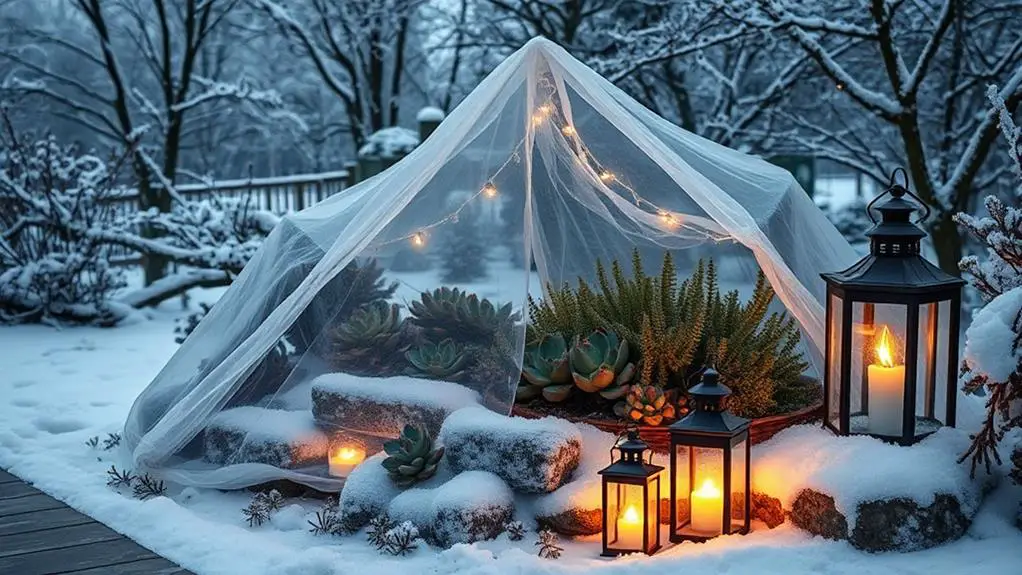
When frost threatens, you'll need to take steps to shield your succulents from the cold. Start by monitoring weather forecasts to know when temperatures are expected to drop near freezing.
If possible, relocate indoor succulents or move them to a sheltered area to maintain a stable temperature. Use cloth or burlap to cover outdoor plants, providing essential insulation. This helps keep temperatures above freezing and prevents frost damage.
Remember, cold-hardy succulents like Sempervivum can tolerate temperatures between 30°F to 40°F, but most others prefer it not to drop below 40°F.
Subscription Services
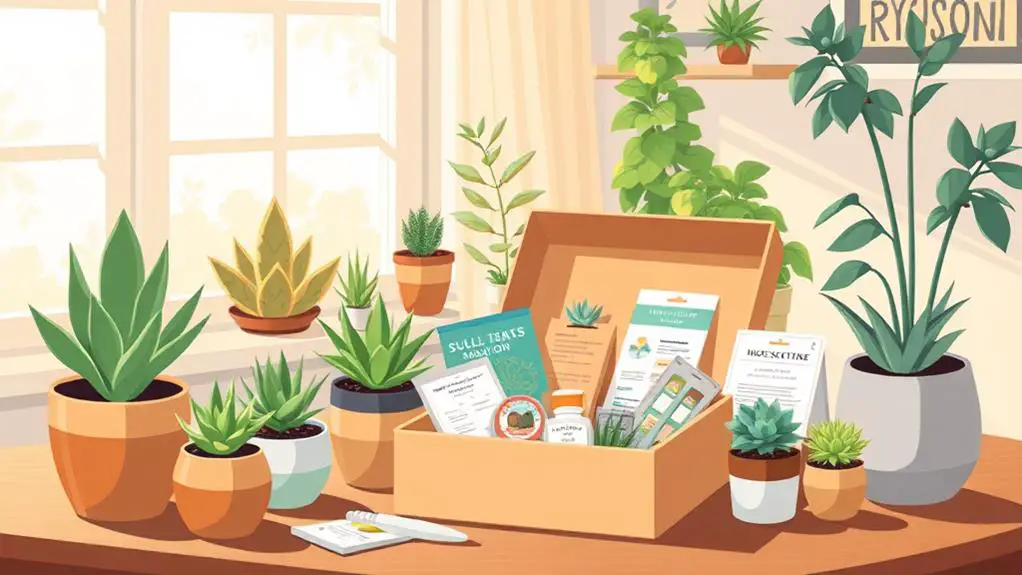
Keeping your succulents in peak condition during colder months might prompt you to explore convenient solutions like subscription services.
Subscription succulent boxes from Succulents Box offer over 300 locally grown varieties, perfect for a temperate climate. Monthly plans let you receive 1 to 4 unique succulents, helping you adapt your collection to changing weather conditions.
Plus, customizable gift options mean you can share this joy with loved ones.
- Hand-packed in California, ensuring quality.
- Dedicated customer service team for plant care tips.
- Helps maintain the deep colors of your succulents.
- Adaptable to various weather conditions.
These services make it easy to keep your succulents thriving, regardless of the season, while ensuring they adapt to their environment.
Maintaining Color
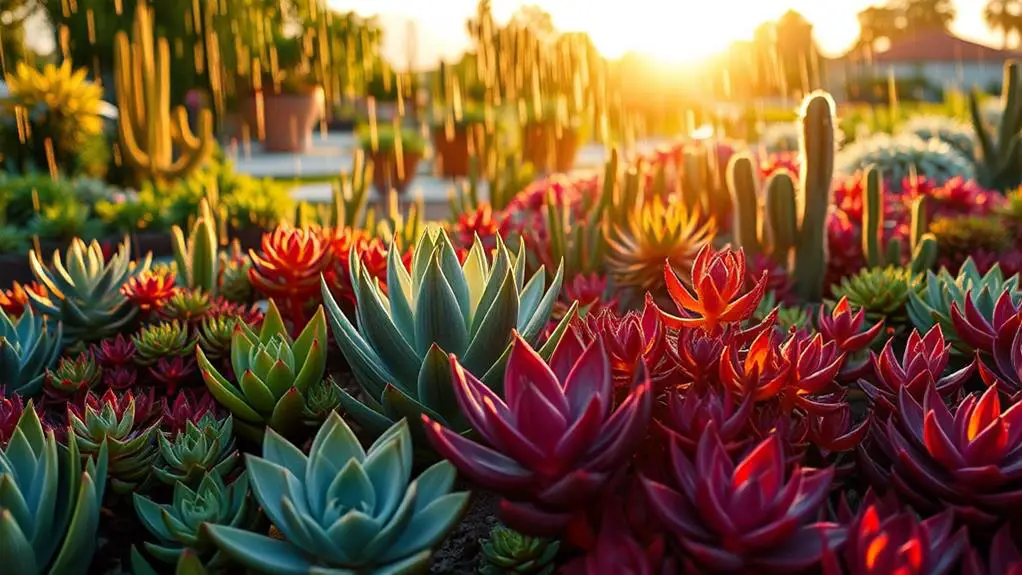
Ensuring your succulents maintain their vibrant colors requires a keen understanding of their light and temperature needs. To maintain the deep colors, provide at least 6 hours of bright sunlight daily. This prevents them from fading to green.
Ideal temperatures for color retention are between 60°F and 80°F. If temperatures drop below 40°F, succulents can stress, intensifying their colors, especially during seasonal shifts.
Watch how your succulents react to weather changes. Warm temperatures above 80°F can enhance colors in soft succulents but may cause sunburn.
Regularly monitor light conditions and adjust exposure gradually to prevent shock. Understanding each succulent species' preferences helps sustain their rich hues, ensuring they thrive and maintain their stunning colors.
Adapting to Weather Changes
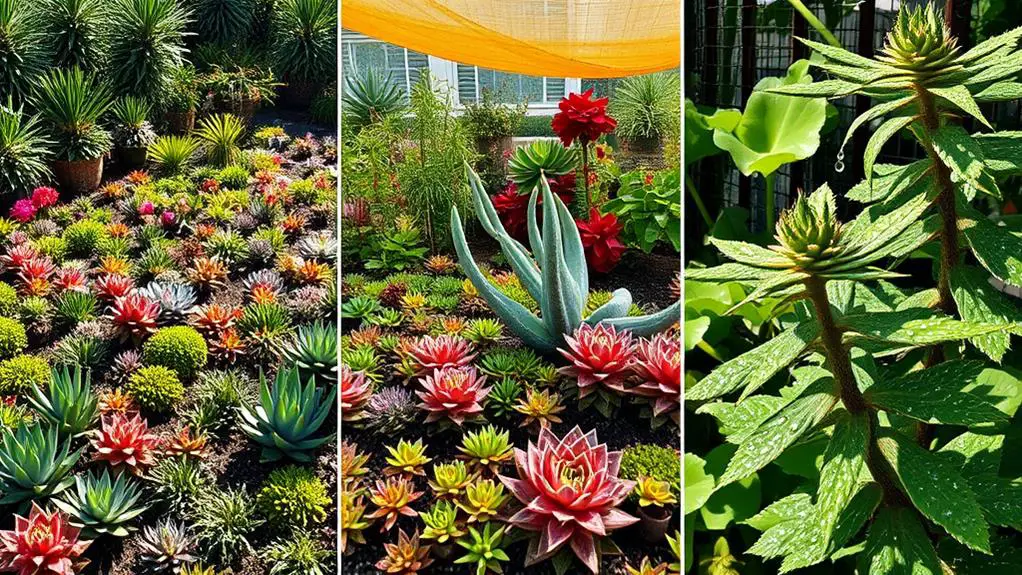
Adapting to weather changes is essential for keeping your succulents healthy and vibrant.
Monitor temperature fluctuations closely, as succulents thrive between 60°F and 80°F. They can handle lows of 40°F and highs up to 90°F but need extra care during extreme conditions.
Gradually introduce them to new light conditions to prevent shock. Protect them from high heat, frost, and potential sunburn by providing shade or cover when necessary.
Adjust watering schedules based on humidity and temperature changes.
- Monitor temperature fluctuations: Keep an eye on the weather.
- Introduce new light slowly: Avoid shocking your plants.
- Protect from extremes: Use shade or covers for high heat or frost.
- Adjust watering schedules: Match your watering to the weather.
Seasonal Care Adjustments
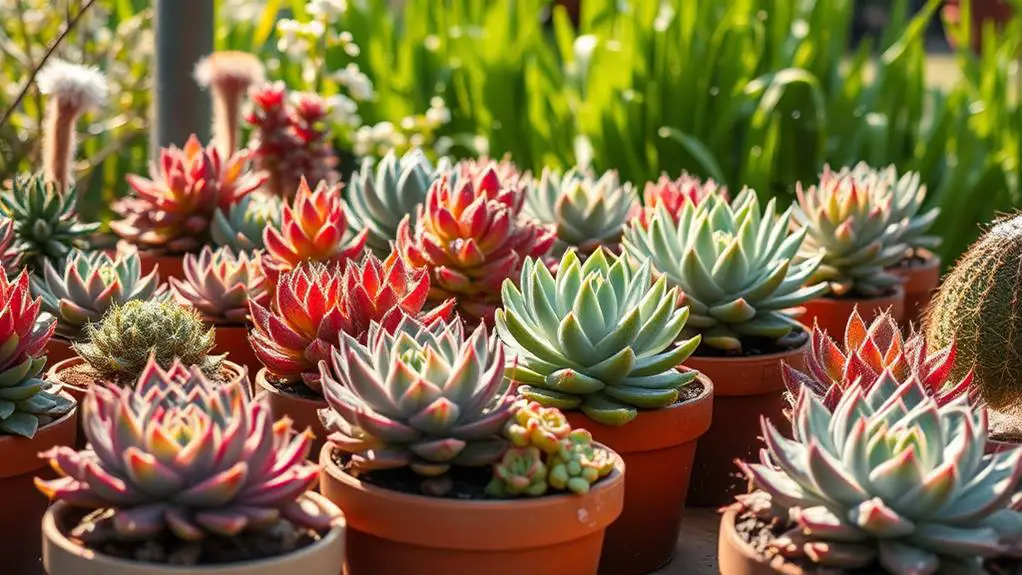
Seasonal care adjustments are essential for maintaining the health and beauty of your succulents. When temperatures drop, move your succulents indoors or cover them with cloth to protect them from frost.
Adjust watering schedules seasonally, reducing it during winter dormancy and increasing it in the growing seasons of spring and summer. Always use well-draining soil.
Monitor humidity levels, especially in tropical climates, to avoid root rot. Gradually introduce succulents to full sun exposure over a week to prevent shock.
During summer, guarantee they get filtered sunlight for at least six hours daily. Regularly monitor root systems for signs of stress or damage.
These adjustments will help your succulents thrive throughout the year.
Resources and Purchases
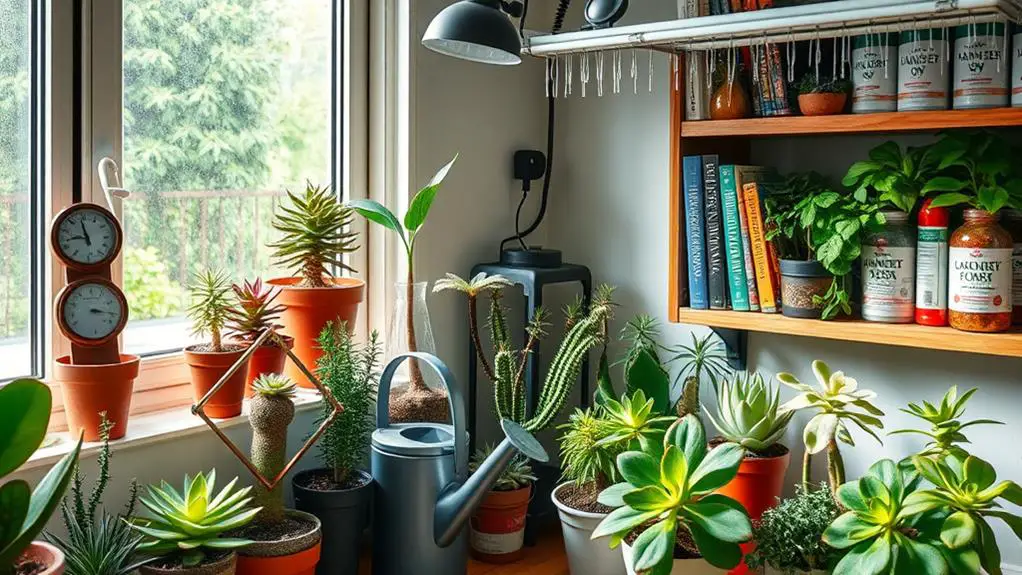
Finding the right resources and making smart purchases are essential for succulent enthusiasts looking to cultivate a vibrant and diverse collection.
Succulents Box offers over 300 varieties of succulents, perfect for expanding your collection. Their plants are locally grown in California, ensuring top quality and freshness, ideal for various climates.
With monthly subscription options, you can receive 1 to 4 hand-packed succulents, making it convenient to grow your collection. Plus, customizable gift options are available, so sharing the joy of succulents is easy.
Dedicated customer service support will help you with any inquiries.
- Over 300 varieties available
- Locally grown in California for quality
- Subscription options for convenience
- Customizable gift options
These resources make growing succulents enjoyable and stress-free.
Frequently Asked Questions
How Do You Fix a Stressed Succulent?
First, check your succulent's environment. Keep temperatures between 60°F and 80°F. Gradually introduce sunlight, avoid overwatering, and guarantee well-draining soil. Protect from frost and inspect for pests or diseases, removing affected leaves and treating accordingly.
What Is the Lowest Temperature a Succulent Can Handle?
Succulents can handle temperatures as low as 40°F, but stress sets in below that. Cold-hardy types like Sempervivum survive down to 30°F. Tropical succulents need it warmer, struggling below 50°F. Protect them by covering or moving indoors.
How Do You Take Care of Succulents in Extreme Heat?
Keep your succulents shaded during peak sun hours, water them early in the morning, and choose containers like terracotta or ceramic. Check soil temperature regularly and monitor them more frequently to prevent stress and damage.
How Do You Fix Damaged Succulents?
To fix damaged succulents, first assess the damage type. Trim sunburned leaves, address root rot by repotting, provide better light for elongated growth, increase watering for wrinkled leaves, and relocate cold-damaged succulents to a warmer spot.
Conclusion
You've got all the tools now to help your succulents thrive in any weather. Remember to monitor temperatures, provide shade, and water wisely. Don't forget to use the right containers and protect your plants from frost. By adjusting your care and staying attentive to your plants' needs, you'll help them grow strong and beautiful. Keep learning and adapting, and soon, you'll be a succulent pro! Happy gardening, and enjoy watching your plants flourish!

